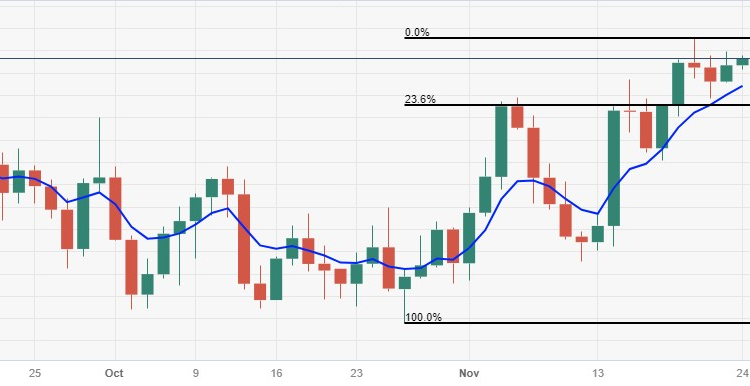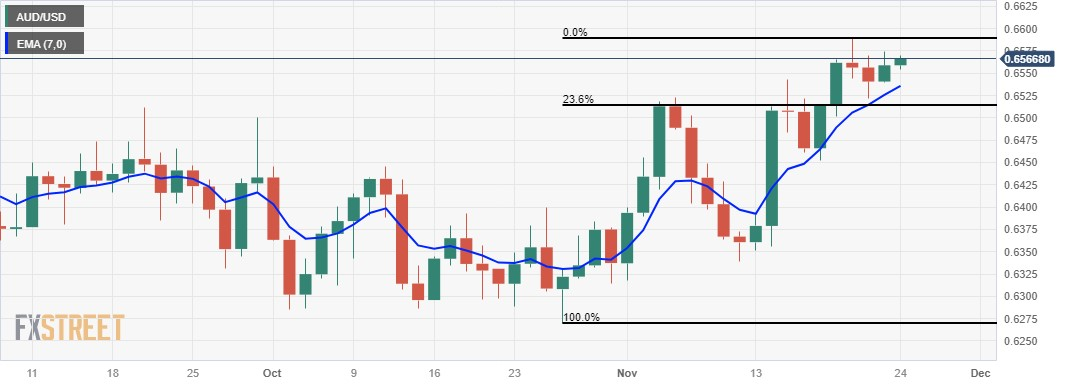Australian Dollar consolidates ahead of US PMI data, remains at the mercy of Greenback
- Australian Dollar could extend gains on the hawkish tone of RBA Governor Bullock.
- Australia’s chief policymaker highlighted that the inflation challenge is fueled by domestic demand.
- US Dollar experiences downward pressure on the growing likelihood of further rate hikes by the Fed.
- Improved US Treasury yields could provide support to underpinning the Greenback.
The Australian Dollar (AUD) struggles to continue the gains as the US Dollar recovers recent losses on Friday. However, the US Dollar (USD) experienced a modest drop on Thursday in a low-volume session, given the closure of United States (US) markets for Thanksgiving.
Australia's Dollar experiences upward support despite Australian PMI hitting multi-month lows. This could be attributed to the hawkish comments from Reserve Bank of Australia (RBA) Governor Michele Bullock. Bullock highlighted that the inflation challenge is increasingly fueled by domestic factors, especially demand. Emphasizing that monetary policy tightening is the suitable response to demand-driven inflation.
The US Dollar Index (DXY) appears to be on a downward trend despite the improvement in US Treasury yields. The growing likelihood of no further interest rate hikes by the Federal Reserve (Fed) contributes to the risk-on factor, which might be undermining the Greenback as market dynamics adjust to the evolving expectations regarding Fed policy.
In the economic calendar, the US S&P Global PMI data are set to be released on Friday, with a slight expected decline in the Services sector from 50.6 to 50.4 and in the Manufacturing sector from 50.0 to 49.8.
Daily Digest Market Movers: Australian Dollar gains ground on hawkish RBA tone, less expectations of Fed rate hikes
- The preliminary Judo Bank Manufacturing PMI (MoM) declined to 47.7 in November, as compared to the previous month's 48.2. Judo Bank Services PMI eased to 46.3 from the prior 47.9, and the Composite PMI decreased to 46.4 from the previous reading of 47.6.
- RBA Governor Michele Bullock mentioned that prices are rising strongly for most goods and services, and service costs are increasing due to high demand. RBA's liaison with firms indicates persistent domestic cost pressures, with high capacity utilization and a tight labor market.
- National Australia Bank (NAB) anticipates another RBA rate hike, expecting it to occur at the February 2024 meeting.
- RBA's meeting minutes revealed that the board acknowledged a “credible case” against an immediate rate hike but considered the case for tightening stronger due to increased inflation risks. The decision on further tightening would hinge on data and risk assessment.
- RBA’s minutes also stressed the importance of preventing even a modest rise in inflation expectations. Board forecasts assumed one or two more rate rises, and rising house prices suggested policy might not be overly restrictive.
- The Federal Open Market Committee (FOMC) meeting minutes reveal that members would entertain the idea of tightening monetary policy further if incoming information suggests insufficient progress toward the Committee's inflation objective.
- FOMC members unanimously agree that policy should stay restrictive for some time until there is clear and sustainable evidence of inflation moving down toward the Committee's target.
- US Jobless Claims showed a greater-than-expected decline in the week ending on November 17, with Initial Claims falling to 209K from 233K.
- US Durable Goods Orders fell 5.4% in October, exceeding the expected 3.1% decline.
- US University of Michigan Consumer Sentiment Index for November stood at 61.3, compared to the expected reading of 60.5.
Technical Analysis: Australian Dollar moves back toward 0.6550
The Australian Dollar hovers around the 0.6560 level on Friday. The AUD/USD pair has successfully surpassed the barrier at the significant 0.6550 level, paving the way for a potential revisit to the three-month high at 0.6589, situated around the psychological resistance of 0.6600. On the downside, the seven-day Exponential Moving Average (EMA) at 0.6536 could serve as crucial support, followed by the 23.6% Fibonacci retracement at 0.6514. A breach below this level might lead the pair to test the major support at the 0.6500 level.
AUD/USD: Daily Chart
Australian Dollar price today
The table below shows the percentage change of Australian Dollar (AUD) against listed major currencies today. Australian Dollar was the strongest against the Canadian Dollar.
| USD | EUR | GBP | CAD | AUD | JPY | NZD | CHF | |
| USD | 0.04% | -0.03% | 0.05% | 0.00% | -0.16% | -0.07% | -0.04% | |
| EUR | -0.03% | -0.05% | 0.02% | -0.03% | -0.18% | -0.10% | -0.07% | |
| GBP | 0.02% | 0.05% | 0.08% | 0.02% | -0.13% | -0.05% | -0.02% | |
| CAD | -0.06% | -0.04% | -0.06% | -0.06% | -0.20% | -0.13% | -0.11% | |
| AUD | -0.02% | 0.02% | -0.05% | 0.04% | -0.17% | -0.09% | -0.05% | |
| JPY | 0.15% | 0.16% | 0.11% | 0.21% | 0.17% | 0.05% | 0.11% | |
| NZD | 0.09% | 0.10% | 0.04% | 0.13% | 0.07% | -0.08% | 0.03% | |
| CHF | 0.04% | 0.07% | 0.02% | 0.10% | 0.05% | -0.11% | -0.03% |
The heat map shows percentage changes of major currencies against each other. The base currency is picked from the left column, while the quote currency is picked from the top row. For example, if you pick the Euro from the left column and move along the horizontal line to the Japanese Yen, the percentage change displayed in the box will represent EUR (base)/JPY (quote).
Risk sentiment FAQs
In the world of financial jargon the two widely used terms “risk-on” and “risk off” refer to the level of risk that investors are willing to stomach during the period referenced. In a “risk-on” market, investors are optimistic about the future and more willing to buy risky assets. In a “risk-off” market investors start to ‘play it safe’ because they are worried about the future, and therefore buy less risky assets that are more certain of bringing a return, even if it is relatively modest.
Typically, during periods of “risk-on”, stock markets will rise, most commodities – except Gold – will also gain in value, since they benefit from a positive growth outlook. The currencies of nations that are heavy commodity exporters strengthen because of increased demand, and Cryptocurrencies rise. In a “risk-off” market, Bonds go up – especially major government Bonds – Gold shines, and safe-haven currencies such as the Japanese Yen, Swiss Franc and US Dollar all benefit.
The Australian Dollar (AUD), the Canadian Dollar (CAD), the New Zealand Dollar (NZD) and minor FX like the Ruble (RUB) and the South African Rand (ZAR), all tend to rise in markets that are “risk-on”. This is because the economies of these currencies are heavily reliant on commodity exports for growth, and commodities tend to rise in price during risk-on periods. This is because investors foresee greater demand for raw materials in the future due to heightened economic activity.
The major currencies that tend to rise during periods of “risk-off” are the US Dollar (USD), the Japanese Yen (JPY) and the Swiss Franc (CHF). The US Dollar, because it is the world’s reserve currency, and because in times of crisis investors buy US government debt, which is seen as safe because the largest economy in the world is unlikely to default. The Yen, from increased demand for Japanese government bonds, because a high proportion are held by domestic investors who are unlikely to dump them – even in a crisis. The Swiss Franc, because strict Swiss banking laws offer investors enhanced capital protection.



Comments are closed.